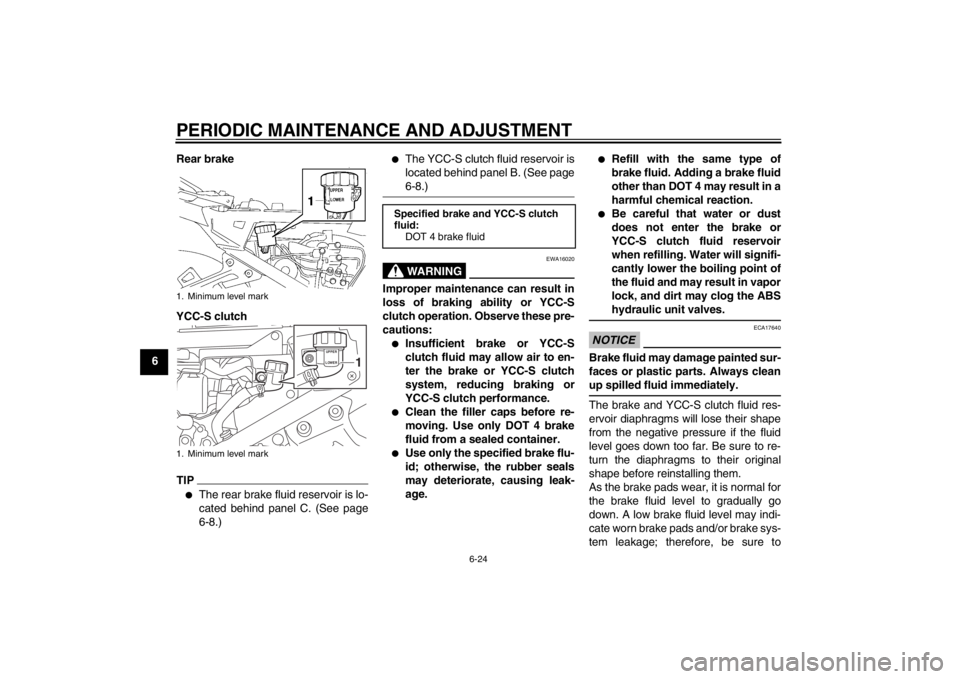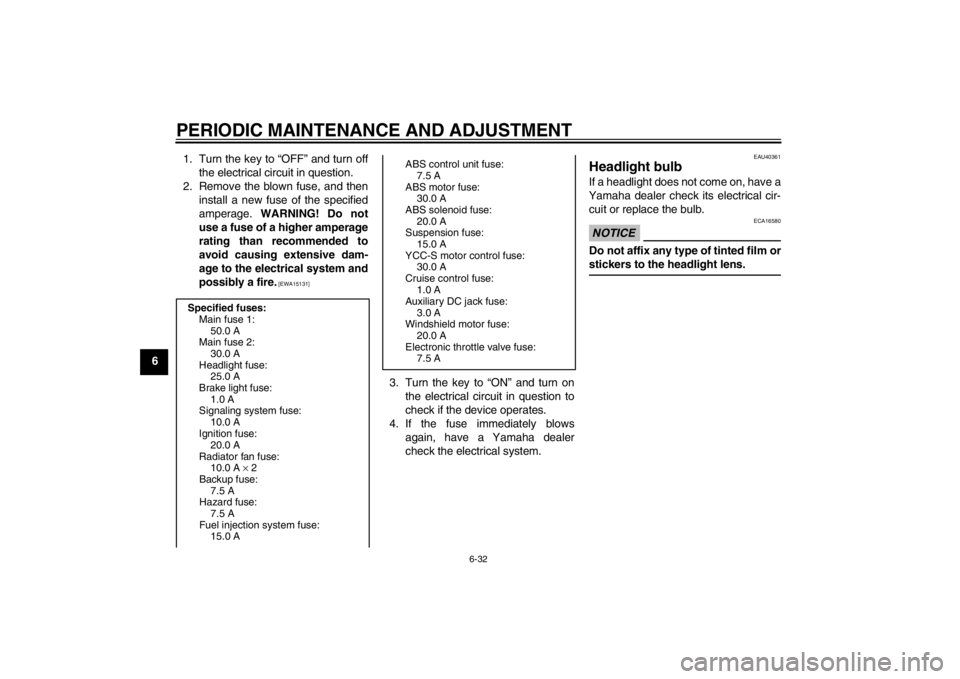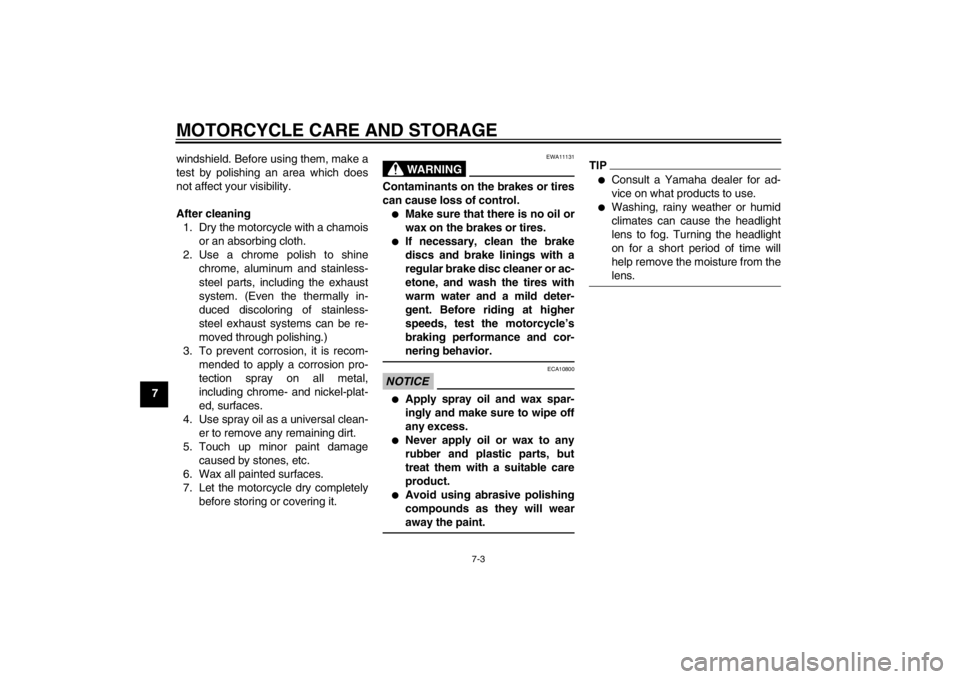ABS YAMAHA FJR1300AS 2013 User Guide
[x] Cancel search | Manufacturer: YAMAHA, Model Year: 2013, Model line: FJR1300AS, Model: YAMAHA FJR1300AS 2013Pages: 122, PDF Size: 3.34 MB
Page 77 of 122

PERIODIC MAINTENANCE AND ADJUSTMENT
6-5
6
10*Swingarm Check operation and for exces-
sive play. √√√√
Lubricate with lithium-soap-based grease. Every 50000 km (30000 mi)
11 *Steering bearings Check bearing play and steering
for roughness. √√√√√
Lubricate with lithium-soap-based grease. Every 20000 km (12000 mi)
12 *Chassis fasteners Make sure that all nuts, bolts and
screws are properly tightened. √√√√√
13 Brake lever pivot
shaft Lubricate with silicone grease.
√√√√√
14 Brake pedal pivot
shaft Lubricate with lithium-soap-based
grease. √√√√√
15 *Shift pedal pivot
shaft Lubricate with lithium-soap-based
grease. √√√√√
16 Sidestand, center-
stand Check operation.
Lubricate with lithium-soap-based
grease. √√√√√
17 *Sidestand switch Check operation. √√√√√√
18 *Front fork Check operation and for oil leak-
age. √√√√
19 *Shock absorber as-
sembly Check operation and shock ab-
sorber for oil leakage. √√√√
NO. ITEM CHECK OR MAINTENANCE JOB
ODOMETER READING
ANNUAL
CHECK
1000 km
(600 mi) 10000 km
(6000 mi) 20000 km
(12000 mi) 30000 km
(18000 mi) 40000 km
(24000 mi)
U1MDE0E0.book Page 5 Friday, February 15, 2013 1:26 PM
Page 96 of 122

PERIODIC MAINTENANCE AND ADJUSTMENT
6-24
6Rear brake
YCC-S clutch
TIP●
The rear brake fluid reservoir is lo-
cated behind panel C. (See page
6-8.)
●
The YCC-S clutch fluid reservoir is
located behind panel B. (See page
6-8.)WARNING
EWA16020
Improper maintenance can result in
loss of braking ability or YCC-S
clutch operation. Observe these pre-
cautions:●
Insufficient brake or YCC-S
clutch fluid may allow air to en-
ter the brake or YCC-S clutch
system, reducing braking or
YCC-S clutch performance.
●
Clean the filler caps before re-
moving. Use only DOT 4 brake
fluid from a sealed container.
●
Use only the specified brake flu-
id; otherwise, the rubber seals
may deteriorate, causing leak-
age.
●
Refill with the same type of
brake fluid. Adding a brake fluid
other than DOT 4 may result in a
harmful chemical reaction.
●
Be careful that water or dust
does not enter the brake or
YCC-S clutch fluid reservoir
when refilling. Water will signifi-
cantly lower the boiling point of
the fluid and may result in vapor
lock, and dirt may clog the ABS
hydraulic unit valves.
NOTICE
ECA17640
Brake fluid may damage painted sur-
faces or plastic parts. Always clean
up spilled fluid immediately.The brake and YCC-S clutch fluid res-
ervoir diaphragms will lose their shape
from the negative pressure if the fluid
level goes down too far. Be sure to re-
turn the diaphragms to their original
shape before reinstalling them.
As the brake pads wear, it is normal for
the brake fluid level to gradually go
down. A low brake fluid level may indi-
cate worn brake pads and/or brake sys-
tem leakage; therefore, be sure to
1. Minimum level mark
1. Minimum level mark
UPPER
LOWER
1
Specified brake and YCC-S clutch
fluid: DOT 4 brake fluid
U1MDE0E0.book Page 24 Friday, February 15, 2013 1:26 PM
Page 103 of 122
![YAMAHA FJR1300AS 2013 User Guide PERIODIC MAINTENANCE AND ADJUSTMENT
6-31
6
is turned to “OFF”, then con-
nect the positive lead before
connecting the negative lead.
[ECA16840]
4. After installation, make sure that
the battery le YAMAHA FJR1300AS 2013 User Guide PERIODIC MAINTENANCE AND ADJUSTMENT
6-31
6
is turned to “OFF”, then con-
nect the positive lead before
connecting the negative lead.
[ECA16840]
4. After installation, make sure that
the battery le](/img/51/49673/w960_49673-102.png)
PERIODIC MAINTENANCE AND ADJUSTMENT
6-31
6
is turned to “OFF”, then con-
nect the positive lead before
connecting the negative lead.
[ECA16840]
4. After installation, make sure that
the battery leads are properly con-
nected to the battery terminals.NOTICE
ECA16530
Always keep the battery charged.
Storing a discharged battery can
cause permanent battery damage.
EAU54512
Replacing the fuses The fuse boxes and individual fuses are
located under panel A. (See page 6-8.)
If a fuse is blown, replace it as follows.1. Main fuse 1
2. Spare fuse
3. Cruise control fuse
4. Brake light fuse
5. Fuse box
6. Main fuse 2
5
1
3
4
2
5 26
1. ABS motor fuse
2. ABS solenoid fuse
3. Fuel injection system fuse
4. Backup fuse (for clock and immobilizer sys-
tem)
5. Electronic throttle valve fuse
6. Headlight fuse
7. Spare fuse
8. YCC-S motor control fuse
9. Suspension fuse
10.Signaling system fuse
11.Auxiliary DC jack fuse
12.ABS control unit fuse
13.Ignition fuse
14.Right radiator fan fuse
15.Left radiator fan fuse
16.Hazard fuse
17.Windshield motor fuse
15
7
11
101213
14
7
17
16
8
1
9
2
3456
7
7
U1MDE0E0.book Page 31 Friday, February 15, 2013 1:26 PM
Page 104 of 122

PERIODIC MAINTENANCE AND ADJUSTMENT
6-32
61. Turn the key to “OFF” and turn off
the electrical circuit in question.
2. Remove the blown fuse, and then install a new fuse of the specified
amperage. WARNING! Do not
use a fuse of a higher amperage
rating than recommended to
avoid causing extensive dam-
age to the electrical system and
possibly a fire.
[EWA15131]
3. Turn the key to “ON” and turn on the electrical circuit in question to
check if the device operates.
4. If the fuse immediately blows again, have a Yamaha dealer
check the electrical system.
EAU40361
Headlight bulb If a headlight does not come on, have a
Yamaha dealer check its electrical cir- cuit or replace the bulb.NOTICE
ECA16580
Do not affix any type of tinted film or
stickers to the headlight lens.
Specified fuses: Main fuse 1:50.0 A
Main fuse 2:
30.0 A
Headlight fuse: 25.0 A
Brake light fuse: 1.0 A
Signaling system fuse:
10.0 A
Ignition fuse: 20.0 A
Radiator fan fuse: 10.0 A × 2
Backup fuse:
7.5 A
Hazard fuse: 7.5 A
Fuel injection system fuse: 15.0 A
ABS control unit fuse:7.5 A
ABS motor fuse: 30.0 A
ABS solenoid fuse: 20.0 A
Suspension fuse:
15.0 A
YCC-S motor control fuse: 30.0 A
Cruise control fuse: 1.0 A
Auxiliary DC jack fuse:
3.0 A
Windshield motor fuse: 20.0 A
Electronic throttle valve fuse: 7.5 A
U1MDE0E0.book Page 32 Friday, February 15, 2013 1:26 PM
Page 112 of 122

MOTORCYCLE CARE AND STORAGE
7-3
7windshield. Before using them, make a
test by polishing an area which does
not affect your visibility.
After cleaning
1. Dry the motorcycle with a chamois or an absorbing cloth.
2. Use a chrome polish to shine chrome, aluminum and stainless-
steel parts, including the exhaust
system. (Even the thermally in-
duced discoloring of stainless-
steel exhaust systems can be re-
moved through polishing.)
3. To prevent corrosion, it is recom- mended to apply a corrosion pro-
tection spray on all metal,
including chrome- and nickel-plat-
ed, surfaces.
4. Use spray oil as a universal clean- er to remove any remaining dirt.
5. Touch up minor paint damage caused by stones, etc.
6. Wax all painted surfaces.
7. Let the motorcycle dry completely before storing or covering it.
WARNING
EWA11131
Contaminants on the brakes or tires
can cause loss of control.●
Make sure that there is no oil or
wax on the brakes or tires.
●
If necessary, clean the brake
discs and brake linings with a
regular brake disc cleaner or ac-
etone, and wash the tires with
warm water and a mild deter-
gent. Before riding at higher
speeds, test the motorcycle’s
braking performance and cor-
nering behavior.
NOTICE
ECA10800
●
Apply spray oil and wax spar-
ingly and make sure to wipe off
any excess.
●
Never apply oil or wax to any
rubber and plastic parts, but
treat them with a suitable care
product.
●
Avoid using abrasive polishing
compounds as they will wear
away the paint.
TIP●
Consult a Yamaha dealer for ad-
vice on what products to use.
●
Washing, rainy weather or humid
climates can cause the headlight
lens to fog. Turning the headlight
on for a short period of time will
help remove the moisture from the
lens.
U1MDE0E0.book Page 3 Friday, February 15, 2013 1:26 PM
Page 116 of 122

SPECIFICATIONS
8-2
8
Secondary reduction ratio:2.698 (35/37 x 21/27 x 33/9)
Transmission type: Constant mesh 5-speed
Operation:
Left foot operation
Gear ratio: 1st:
2.529 (43/17)
2nd: 1.773 (39/22)
3rd: 1.348 (31/23)
4th:
1.077 (28/26)
5th: 0.929 (26/28)Chassis:Frame type:
Diamond
Caster angle: 26.00 °
Trail: 109 mm (4.3 in)Front tire:Type:Tubeless
Size: 120/70 ZR17M/C (58W)
Manufacturer/model:
BRIDGESTONE/BT023F ERear tire:Type:Tubeless Size:
180/55 ZR17M/C (73W)
Manufacturer/model: BRIDGESTONE/BT023R E
Loading:Maximum load:208 kg (459 lb)
(Total weight of rider, passenger, cargo and
accessories)Tire air pressure (measured on cold
tires):Loading condition:0–90 kg (0–198 lb)
Front:
250 kPa (2.50 kgf/cm², 36 psi)
Rear: 290 kPa (2.90 kgf/cm², 42 psi)
Loading condition: 90–208 kg (198–459 lb)
Front:
250 kPa (2.50 kgf/cm², 36 psi)
Rear: 290 kPa (2.90 kgf/cm², 42 psi)
High-speed riding: Front: 250 kPa (2.50 kgf/cm², 36 psi)
Rear: 290 kPa (2.90 kgf/cm², 42 psi)Front wheel:Wheel type:Cast wheel
Rim size: 17M/C x MT3.50
Rear wheel:Wheel type:Cast wheel
Rim size:
17M/C x MT5.50Unified brake system:Operation:Activated by rear brakeFront brake:Type:Dual disc brake
Operation: Right hand operation
Specified brake fluid:
DOT 4Rear brake:Type:Single disc brake
Operation:
Right foot operation
Specified brake fluid: DOT 4Front suspension:Type:
Telescopic fork
Spring/shock absorber type: Coil spring/oil damper
Wheel travel: 135.0 mm (5.31 in)Rear suspension:Type:Swingarm (link suspension)
Spring/shock absorber type: Coil spring/gas-oil damper
U1MDE0E0.book Page 2 Friday, February 15, 2013 1:26 PM
Page 117 of 122

SPECIFICATIONS
8-3
8
Wheel travel:125.0 mm (4.92 in)Electrical system:Ignition system:
TCI
Charging system: AC magnetoBattery:Model:
GT14B-4
Voltage, capacity: 12 V, 12.0 AhHeadlight:Bulb type:
Halogen bulbBulb voltage, wattage × quantity:Headlight:
12 V, 60.0 W/55.0 W × 2
Tail/brake light:
12 V, 5.0 W/21.0 W × 2
Front turn signal light: LED
Rear turn signal light: 12 V, 21.0 W × 2
Auxiliary light:
LED
License plate light: 12 V, 5.0 W × 1
Meter lighting: LED
Neutral indicator light:
LED
High beam indicator light: LED Oil level warning light:
LED
Turn signal indicator light: LED
Engine trouble warning light:
LED
ABS warning light: LED
Cruise control “SET” indicator light: LED
Cruise control “ON” indicator light:
LED
Immobilizer system indicator light: LED
Traction control system indicator/warning
light: LED
"STOP MODE" indicator light: LED
Shift down indicator light:
LED
YCC-S system warning light: LED
Suspension warning light: LED
Fuses:Main fuse 1:50.0 A
Main fuse 2: 30.0 A
Headlight fuse:
25.0 A
Brake light fuse: 1.0 A Signaling system fuse:
10.0 A
Ignition fuse: 20.0 A
Radiator fan fuse:
10.0 A × 2
Hazard fuse: 7.5 A
Fuel injection system fuse: 15.0 A
ABS control unit fuse:
7.5 A
ABS motor fuse: 30.0 A
ABS solenoid fuse: 20.0 A
Suspension fuse:
15.0 A
Cruise control fuse: 1.0 A
Auxiliary DC jack fuse: 3.0 A
YCC-S motor control fuse:
30.0 A
Backup fuse: 7.5 A
Windshield motor fuse: 20.0 A
Electronic throttle valve fuse:
7.5 A
U1MDE0E0.book Page 3 Friday, February 15, 2013 1:26 PM
Page 119 of 122

INDEX
AABS ...................................................... 3-29
ABS warning light ................................... 3-5
Accessory box ...................................... 3-39
Air filter element.................................... 6-17
Auxiliary DC jack .................................. 3-49
Auxiliary light ........................................ 6-34BBattery .................................................. 6-30
Brake and shift pedals, checking and lubricating ........................................... 6-26
Brake and YCC-S clutch fluid levels,
checking ............................................. 6-23
Brake and YCC-S clutch fluids, changing ............................................. 6-25
Brake lever ........................................... 3-29
Brake lever, checking and lubricating ... 6-27
Brake lever free play, checking ............ 6-22
Brake light switches .............................. 6-22
Brake pedal .......................................... 3-29CCables, checking and lubricating .......... 6-25
Care ........................................................ 7-1
Catalytic converters .............................. 3-34
Centerstand and sidestand, checking and lubricating .................................... 6-27
Coolant ................................................. 6-16
Cowling vents, opening and closing ..... 3-40
Cruise control indicator lights ................. 3-4
Cruise control switches ......................... 3-26
Cruise control system ............................. 3-7DDimmer/Pass switch ............................. 3-25
D-mode (drive mode)............................ 3-24
EElectronically adjustable suspension system warning light .............................3-6
Engine break-in .......................................5-4
Engine idling speed, checking............... 6-17
Engine oil and oil filter cartridge ............ 6-12
Engine trouble warning light .................... 3-4FFinal gear oil.......................................... 6-14
Front and rear brake pads, checking .... 6-23
Front fork, checking...............................6-28
Front turn signal light............................. 6-33
Fuel ....................................................... 3-33
Fuel consumption, tips for reducing ........ 5-4
Fuel tank breather/overflow hose .......... 3-34
Fuel tank cap......................................... 3-32
Fuses, replacing .................................... 6-31HHandlebar position, adjusting ................ 3-40
Handlebar switches ............................... 3-25
Hand shift lever ..................................... 3-28
Hazard switch........................................ 3-26
Headlight beams, adjusting ................... 3-39
Headlight bulb ....................................... 6-32
High beam indicator light......................... 3-4
Horn switch ........................................... 3-26IIdentification numbers ............................. 9-1
Ignition circuit cut-off system ................. 3-47
Immobilizer system .................................3-1
Immobilizer system indicator light ........... 3-7
Indicator lights and warning lights ........... 3-4LLicense plate light bulb, replacing ......... 6-34
MMain switch/steering lock ........................ 3-2
Maintenance and lubrication, periodic .... 6-4
Maintenance, emission control system ... 6-3
Matte color, caution ................................ 7-1
Menu switch .......................................... 3-26
Model label ............................................. 9-1
Multi-function meter unit ....................... 3-11NNeutral indicator light .............................. 3-4OOil level warning light .............................. 3-4PPanels, removing and installing .............. 6-8
Parking.................................................... 5-5
Part locations .......................................... 2-1RRear suspension, lubricating ................ 6-28
Rear view mirrors.................................. 3-41
Rider seat height, adjusting .................. 3-36SSafety information ................................... 1-1
Seats..................................................... 3-35
Select switch ......................................... 3-26
Shift down indicator light ......................... 3-6
Shifting .................................................... 5-3
Shift pedal ............................................. 3-28
Sidestand .............................................. 3-46
Spark plugs, checking........................... 6-11
Specifications.......................................... 8-1
Start/Engine stop switch ....................... 3-26
Starting the engine.................................. 5-1
Steering, checking ................................ 6-29
Stop mode function indicator light........... 3-6
U1MDE0E0.book Page 1 Friday, February 15, 2013 1:26 PM